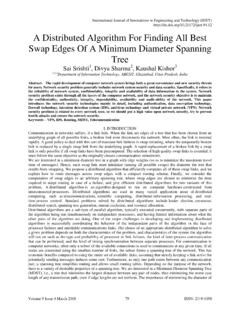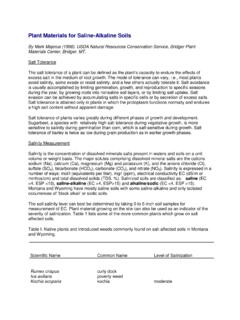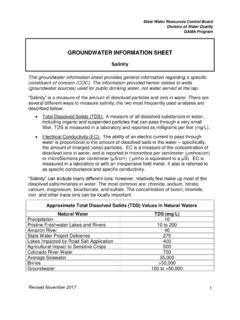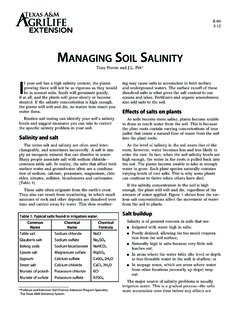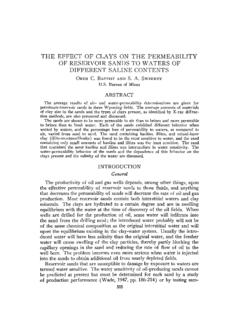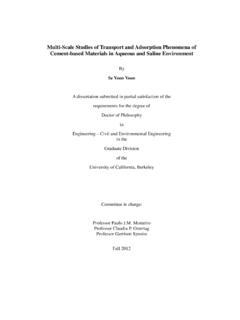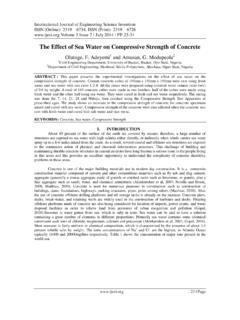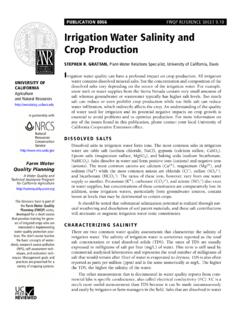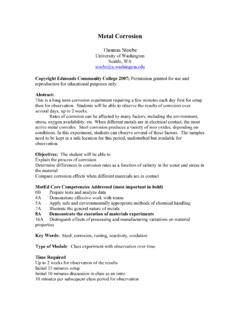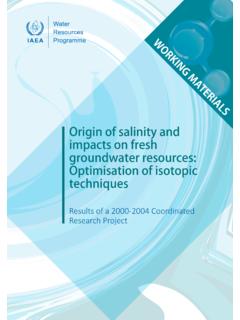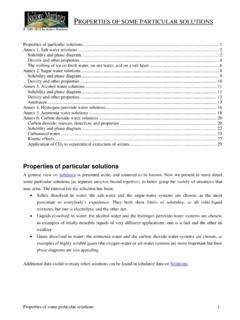Transcription of Variation of damping property of polymer composite under ...
1 Variation of damping property of polymer composite under saline water treatment Sridhar I Department of Mechanical Engineering S. D. M. College of Engineering & Technology Dharwad, Karnataka, India Venkatesha C S Department of Mechanical Engineering U. B. D. T. College of Engineering Davangere, Karnataka, India Abstract- polymer composites are replacing the conventional materials for use in both offshore and onshore applications due to their excellent corrosion resistant and good mechanical properties. These composites are subjected to different environmental conditions during their service. The composite dynamic behavior under different environments needs to be studied for their proper functioning.
2 damping is an important dynamic property that needs to be evaluated for design against vibration. This study provides test results of damping behavior of glass fibre reinforced composites subjected to saline water treatment. damping behavior was studied using free vibration decay method for different fibre volumes at regular intervals of time. The study shows that there is a decrease in damping value by a maximum of 47% of the composites. Keywords: damping , environment, glass fibre, influence. Glass fibre reinforced polymer (GFRP) composites owing to their high specific strength and anti-corrosive property are used in many light weight and marine applications than conventional materials.
3 These composites are subjected to severe environments and their dynamic behavior under these environments is important from the design point of view. The damping performance is an important parameter for composite structures which are subjected to dynamic loading and vibration during working. Different theoretical and experimental methods are available for determining the damping of the composites. Many researchers have successfully determined the damping behavior of unidirectional and multidirectional polymer composites [1-11]. Woven fabric polymer composites give better mechanical properties in both the directions.
4 Energy dissipation by these composites is important when they are subjected to vibration. Many factors influence the energy dissipation of FRP composites like fiber orientation, fiber volume, matrix material, moisture, temperature and others. Research has been done to find the effect of hot and wet moisture absorption by the composites on damping properties [12, 13]. While most of the research is done on moisture or temperature effects on damping properties of composites, no data is available on the effect of long term liquid ageing on the damping properties of GFRP composites.
5 In the present work, the authors have carried out experiments to study the effect of liquid ageing on the damping property of GFRP composites. The composites were subjected to liquid ageing in saline water and their damping behavior is studied. Materials and Fabrication The specimens were made by hand laying plain woven E-glass fabric cut to appropriate size. Commercially available Araldite epoxy LY556 and hardener HY951 mixed in appropriate proportion (10:1) were used to cast the specimens. The cast specimens were cured at room temperature for approximately 48 hours. The specimens were then cut to appropriate size.
6 The dimensions of the specimens were 330x50x3 mm. Five different vibration specimens (VS1-VS5) were fabricated by varying the volume percentage of the glass fabric as given in Table 1. International Journal of Innovations in Engineering and Technology (IJIET)Vol. 2 Issue 1 February 2013420 ISSN: 2319 1058 Table-1 damping factor and volume percentage of Glass fabric for the untreated vibration specimens Experimental Method The specimens prepared were soaked in saline water at room temperature. Vibration testing was done on the specimens for every 15 days of soaking and up to 60 days maximum. Before proceeding to testing, the specimens were cleaned by tissue paper so that no liquid is present on the specimen.
7 The specimens were then subjected to vibration using impact load and the vibration decay plot was obtained. The span length of the beam specimen was 300mm. The vibration decay plot thus obtained was used for measurement of damping . To calculate the damping factor , the logarithmic decrement is evaluated from the vibration decay plot using equation (1) [14]. (1) Where x 1 and xM+1 are the amplitudes of vibration at 1st and Mth oscillations. Then damping factor is given by (2) For small amount of damping equation (2) can be rewritten as (3) Equation (3) is used to calculate the damping factor of the composites.
8 For each specimen a minimum of three readings and a maximum of six readings were taken and average damping factor was calculated. AND DISCUSSION damping behavior of untreated specimens Table-1 shows the damping factor values for different untreated (dry) specimens. It can be observed that the damping increases as the volume percentage of fiber increased. This may be due to the increased stiffness of the specimen as fiber volume is increased and also due to more energy dissipation at the fiber matrix interphase which increases as the fibre volume increase. SPECIMEN Volume % of Glass fabric damping factor (x 10-3) VS1 20 VS2 25 VS3 30 VS4 35 VS5 40 International Journal of Innovations in Engineering and Technology (IJIET)Vol.
9 2 Issue 1 February 2013421 ISSN: 2319 Effect of saline water The damping values for the specimens soaked in saline water are presented in Table 2. Table-2. damping factor for different specimens immersed in saline water For specimens soaked for 15days the damping decreased initially. The decrease in damping values is rather small. The decrease in the damping values ranged from 7-39%. Maximum decrease in the damping values was observed for 35% fibre volume specimen. The decrease in the damping values may be attributed to the high plasticization of the matrix material of the composite . As observed to naked eye plasticization was more in case of saline water treated specimens.
10 Plasticization leads to reduction in stiffness of the composite and this decreases the damping of the composite . Further reduction in the damping was observed for specimens soaked for 30 days. In this case, may be the water uptake was not much by the composite and further plasticization of the composite lead to the reduction in the damping values of the composite . Also this shows that the water has not reached the fibre-matrix interphase so as to cause degradation which acts as an additional site for energy dissipation. The decrease in the damping values is from a minimum of 12% to a maximum of 47%.

